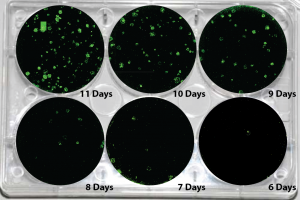R-iPSC
Is “100% Conversion” No Longer a Taboo Phrase in the iPSC Field?
“By removing a single protein called Mbd3, a team at the Weizmann Institute of Science in Rehovot, Israel, was able to increase the conversion rate to almost 100%”. A staggering statement written by Monya Baker for Nature News, after her journal’s online publication by Rais et al. reported their discovery. This discovery displays that by removing the expression of nucleosome remodeling and deacetylation repressor complex member Mbd3, all cells can be reprogrammed with the OSKM Yamanaka factors. What we have described last September in Nature’s Scientific Reports (Warren et al. 2012) that by fusing Oct4 with strong transcription activation domain, we achieved essentially the same results which we call “bulk conversion”. One can imagine that the strong transcription activation domain very likely effects such strong reprogramming through some type of chromosomal remodeling indirectly.
As we later learned, people in the field believe that reprogramming is a stochastic event and it is impossible to achieve something like “bulk conversion”. We are happy to see that sea change now that a separate group also demonstrated “bulk conversion”. Recently we have shown that instead of 2 weeks or more, as required when mRNA reprogramming was first reported or commonly practiced, we could start taking up iPSCs around a week without doing any traditional transfection—just change the medium everyday as for all stem cell cultures, with mRNA complex as a supplement to be added together with bFGF.
Knocking-down Mbd3 is potentially useful, especially in situations where we have difficulty reprogramming a particular line, and it could make reprogramming more successful in more demanding conditions such as leaving out B18R as we recently established. However one needs to be cautious about the unavoidable off-target effects of siRNAs when including siRNA against Mbd3 in their RNA mix.
Rais et al. Nature (2013)
Picture Blog — Human mRNA-Induced Pluripotent Stem Cells Generated in Days
R-iPS Cell FAQ 1:
What phenotypic changes can be observed during a successful reprogramming trial?
About one week out, target fibroblasts should show an involution of fibroblastic processes, and foci or clusters of epitheliod cells—ideally with small nuclei, minimal cytoplasm, and signs of ongoing mitosis—should appear. Colonies with hESC morphology typically start emerging in ~10-14 days.
Categories
- Allele Mail Bag
- cGMP
- Customer Feedback
- Fluorescent proteins
- iPSCs and other stem cells
- nAb: Camelid Antibodies, Nanobodies, VHH
- Next Generation Sequencing (NextGen Seq)
- NIH Budget and You
- oligos and cloning
- Open Forum
- RNAi patent landscape
- SBIR and Business issues
- State of Research
- Synthetic biology
- Uncategorized
- Viruses and cells
- You have the power
Archives
- October 2018
- April 2018
- March 2018
- January 2018
- October 2017
- September 2017
- August 2017
- March 2017
- February 2017
- January 2017
- November 2016
- September 2016
- August 2016
- July 2016
- June 2016
- May 2016
- April 2016
- February 2016
- October 2015
- September 2015
- August 2015
- June 2015
- March 2015
- January 2015
- December 2014
- March 2014
- February 2014
- January 2014
- December 2013
- November 2013
- October 2013
- September 2013
- August 2013
- July 2013
- June 2013
- May 2013
- April 2013
- March 2013
- January 2013
- December 2012
- November 2012
- October 2012
- September 2012
- August 2012
- July 2012
- May 2012
- April 2012
- February 2012
- January 2012
- December 2011
- November 2011
- October 2011
- September 2011
- August 2011
- July 2011
- June 2011
- May 2011
- April 2011
- March 2011
- February 2011
- January 2011
- December 2010
- November 2010
- October 2010
- September 2010
- August 2010
- July 2010
- June 2010
- May 2010
- April 2010
- March 2010
- February 2010
- January 2010
- December 2009
- November 2009
- October 2009
- September 2009
- August 2009
- July 2009
- June 2009
- May 2009
- April 2009
- March 2009
- February 2009
- January 2009
- December 2008
- October 2008
- August 2008
- July 2008




